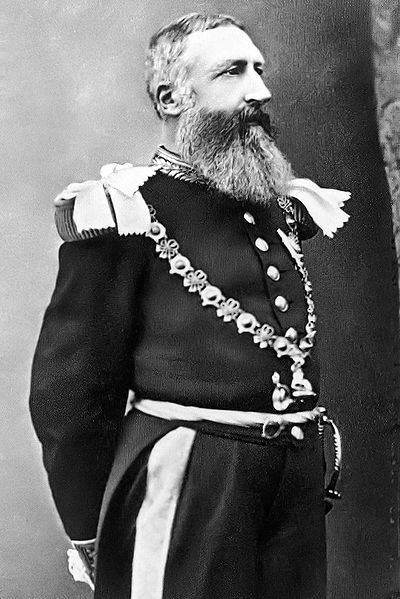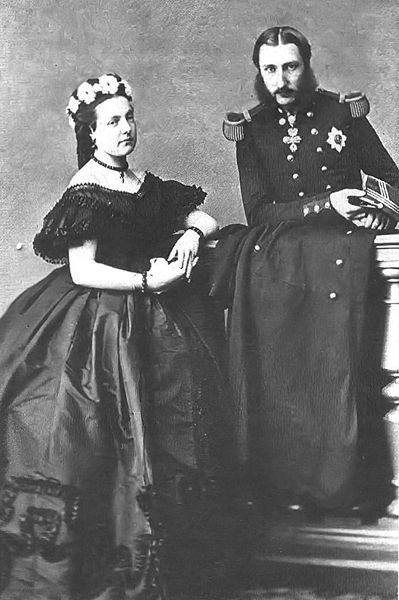<Back to Index>
- Physicist Thomas Johann Seebeck, 1770
- Photographer Eadweard James Muybridge, 1830
- King of the Belgians Leopold II, 1835


Leopold II (French: Léopold Louis Philippe Marie Victor, Dutch: Leopold Lodewijk Filips Maria Victor) (9 April 1835 – 17 December 1909) was King of the Belgians. Born in Brussels the second (but eldest surviving) son of Leopold I and Louise-Marie of Orléans, he succeeded his father to the throne in 1865 and remained king until his death. He was the brother of Empress Carlota of Mexico and first cousin to Queen Victoria of the United Kingdom.
Leopold
is chiefly remembered as the founder and sole owner of the Congo
Free
State, a private project undertaken by the King. He used Henry
Morton
Stanley to
help him lay claim to the Congo, an area now known as the Democratic
Republic
of the Congo. The Powers at Berlin
Conference agreed
to set up the Free State in 1885, on condition that the inhabitants
were to be brought into the modern world and that all nations be
allowed to trade freely. From the beginning, however, Leopold
essentially ignored these conditions and ran the Congo brutally, by
proxy through a mercenary force, for his own personal gain. He
extracted a personal fortune from the Congo, initially by the
collection of ivory, and after a rise in the price of rubber in the
1890s by forcing the native population to collect sap from rubber
plants. His harsh regime was directly or indirectly responsible for the
death of millions of people. The Congo became one of the most infamous
international scandals of the early 20th century, and Leopold was
ultimately forced to relinquish control of it to the government of
Belgium. Leopold
II married teenage Habsburg duchess Marie
Henriette
Anne of Austria in Brussels on
22
August 1853. Leopold was too ill to attend his own wedding, and sent
his brother-in-law, Archduke Charles, to stand in for him.
Unfortunately for the sexually naïve Marie Henrietta, who had gone
to her wedding bed armed only with instructions to submit to her
husband’s wishes, Leopold sufficiently recovered to attend the
honeymoon. They had four children. Leopold
II was also the father of two illegitimate sons. Their mother was Blanche Zélia
Joséphine Delacroix, aka Caroline Lacroix, a prostitute with whom the King engaged
in a religious ceremony on 12 December/14 December 1909, with no
validity under Belgian law, at the Pavilion of Palms, Royal
Palace
of Laken, in Brussels,
five
days before his death. The Priest of Laeken Cooreman performed the
ceremony. These sons were adopted in
1910 by Lacroix's second husband, Antoine Durrieux. He was
the 975th Knight of the Order
of
the Golden Fleece in Austria,
the
748th Knight of the Order
of
the Garter in
1866 and the 69th and 321st Grand
Cross of the Order
of
the Tower and Sword. On 15
November 1902, Italian anarchist Gennaro
Rubino attempted to assassinate Leopold,
who
was riding in a royal cortege from a ceremony in memory of his
recently deceased wife, Marie Henriette. After Leopold's carriage
passed, Rubino fired three shots at the King; the shots missed Leopold
and Rubino was immediately arrested. In
Belgian domestic politics, Leopold emphasized military defense as the
basis of neutrality, but he was unable to obtain a universal
conscription law
until on his death bed. He died in Laeken on 17 December 1909, and
was interred in the royal vault at the Church of Our Lady, Laeken
Cemetery, Brussels. He was
succeeded as King of the Belgians by his nephew Albert,
son
of his brother Philippe.
Leopold
fervently
believed that overseas colonies were the key to a country's
greatness, and he worked tirelessly to acquire colonial territory for
Belgium. Neither the Belgian
people nor the Belgian
government were
interested, however, and Leopold eventually began trying to acquire a
colony in his private capacity as an ordinary citizen. The Belgian
government lent him money for this venture. After a number of unsuccessful schemes for colonies in Africa or Asia, in 1876
he organized a private holding
company disguised
as an international scientific and philanthropic association, which he
called the International
African
Society. In 1878,
under the auspices of the holding company, he hired the famous explorer Henry
Morton
Stanley to
establish a colony in the Congo region. Much diplomatic maneuvering resulted in the Berlin
Conference of
1884–85, at which representatives of fourteen European countries and the United
States recognized
Leopold as sovereign of most of the area he and Stanley had laid claim
to. On 5 February 1885, the result was the Congo Free
State (later
becoming, successively, the Belgian
Congo, the Republic
of
the Congo, Zaire,
and
now the Democratic
Republic of the Congo or
DRC — not to be confused with Republic
of
the Congo formerly owned by France), an area 76 times larger than Belgium, which Leopold was free to rule as a personal domain through his private
army, the Force
Publique.
Abandoning
the
promises of the Berlin Conference in the late 1890s Forced
labor was extorted
from the natives. The abuses suffered were horrific not only in the rubber industry, including the
effective enslavement and sometimes mutilation of the native population. Missionary John Harris of Baringa,
for
example, was so shocked by what he had come across that he wrote to
Leopold's chief agent in the Congo saying: "I have just returned from a
journey inland to the village of Insongo Mboyo. The abject misery and
utter abandon is positively indescribable. I was so moved, Your
Excellency, by the people's stories that I took the liberty of
promising them that in future you will only kill them for crimes they
commit." Estimates
of the death toll range from a realistic two million to an unlikely
fifteen million. Determining
precisely
how many people died is next to impossible as accurate
records were not kept.
Adam
Hochschild devotes
a chapter of his book, King
Leopold's
Ghost,
to the problem of estimating the death toll.
He cites several recent lines of investigation, by anthropologist Jan
Vansina and others, examining local sources, from police records,
religious records, oral traditions, genealogies, personal diaries, and
"many others", which generally agree with the assessment of the 1919
Belgian government commission: roughly half the population perished
during the Free State period. Since the first official census by the
Belgian authorities in 1924 put the population at about 10 million,
that implies a rough estimate of 10 million dead. This assessment has been
challenged by more recent studies of the 1919 commission's methods of
estimation. Smallpox and sleeping sickness also
devastated the population. By 1896 the sleeping
sickness had killed
up to 5,000 Africans in the village of Lukolela on the Congo
River. The mortality figures were gained through the efforts of
Roger Casement, who found only 600 survivors of the disease in Lukolela
in 1903. Reports
of outrageous exploitation and widespread human
rights abuses led
to international outcry in the early 1900s. The campaign to examine
Leopold's regime, led by British diplomat Roger
Casement and former
shipping clerk E.D.
Morel under the
auspices of the Congo Reform Association, became the first mass human
rights movement. Supporters included
American writer Mark
Twain, who wrote a stinging political
satire entitled King
Leopold's
Soliloquy, in which the King supposedly argues that
bringing Christianity to the country outweighs a little starvation.
Rubber gatherers were tortured, maimed and slaughtered until the turn
of the century, when the Western world forced Brussels to call a halt. Arthur
Conan
Doyle also
blasted the 'rubber regime' in his 1908 work 'The Crime of the Congo', written to aid the work of the Congo
Reform
Association. Doyle contrasted Leopold's rule to the British
rule of Nigeria,
arguing
decency required that those who ruled primitive peoples to be
concerned first with their uplift, not how much could be extracted from
them. Doyles work is the most complete contemporary account of the
Congo scandal. It should be noted that, as Hochschild describes in King Leopold's Ghost,
Imperial
Germany and to a lesser extent France and Portugal adopted the
Congo methods to some extent in those parts of their colonies where
natural rubber occurred. Finally,
in 1908, the Belgian
parliament compelled
the
King to cede the Congo Free State to Belgium. Emperor Franz
Joseph of Austria-Hungary once described his fellow
ruler as a "thoroughly bad man". Leopold
II is still a controversial figure in the Democratic
Republic
of Congo; in 2005 his statue was taken down just hours
after it was re-erected in the capital, Kinshasa.
The
Congolese culture minister, Christoph Muzungu, decided to reinstate
the statue, pointing out the sense of liberating progress that had
marked the beginning of the Free State and arguing people should see
the positive aspects of the king as well as the negative. But just
hours after the six metre (20 ft) statue was erected in the middle
of a roundabout near Kinshasa's central station, it was taken down
again, without explanation. The Congo continues, however, to use a
variation of the Free State flag, which it adopted after dropping the
name and flag of Zaire. Though
extremely
disliked by his subjects at the end of his reign — his
funeral cortege was booed — Leopold II is remembered today by many
Belgians as the "Builder King" (Koning-Bouwer in Dutch, le Roi-Bâtisseur in French)
because
he commissioned a great number of buildings and urban projects,
mainly in Brussels, Ostend and Antwerp. These
buildings include the Royal Glasshouses in the grounds of the Palace at Laken,
the
Japanese Tower, the Chinese Pavilion, the Musée du Congo (now called the Royal
Museum
for Central Africa), and their surrounding park in Tervuren,
the Cinquantenaire in Brussels, and the
Antwerp railway station hall. He also built an important country
estate in Saint-Jean-Cap-Ferrat on the French
Riviera, including the Villa
des
Cèdres, which is now a botanical garden. These were all built using the profits from the Congo. In
1900, he created the Royal
Trust, by which means he donated most of his property to the
Belgian nation.
After the
King transferred his private colony to Belgium, there was, as Adam
Hochschild puts it
in King
Leopold's
Ghost, a "Great Forgetting". Hochschild records that,
on his visit to the colonial Royal Museum for Central Africa in the
1990s, there was no mention of the atrocities committed in the Congo
Free State, despite the museum's large collection of colonial objects.
Another example of this "Great Forgetting" may be found on the
boardwalk of Blankenberge,
a
popular coastal resort, where a monument shows a colonialist bringing
"civilization" to the black child at his feet. However an activist
group cut off the hands of a statue of Leopold II in Ostend to protest
the Congo atrocities.